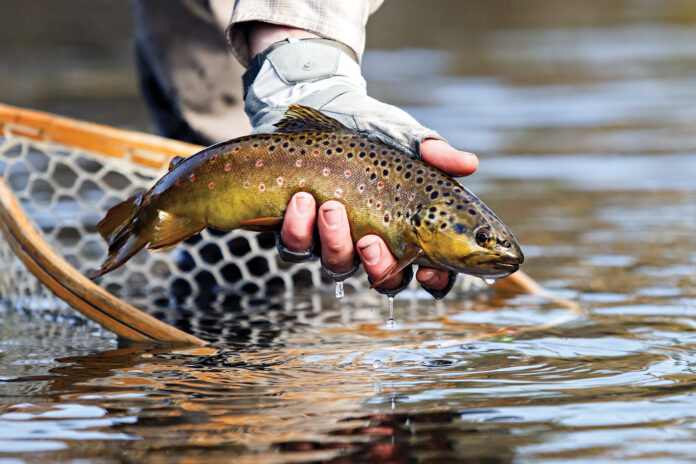In the 30 years since Robert Redford’s award-winning film “A River Runs Through It” transformed Montana’s fly-fishing tourism industry — which spiked by a magnitude of 60% in 1992, the year the movie came out, and again in 1993 — the Treasure State’s seemingly indefatigable pastime, as well as the fisheries it depends on, has not only endured a 280% increase in nonresident fishing pressure, but it has also survived extreme drought, reduced streamflows and warming water temperatures.
Despite this proven resiliency, climate change may put the long-term viability of Montana’s most popular trout fisheries at risk, according to a study published this month in the journal Science Advances.
The study’s findings are based on a collaboration between scientists with the U.S. Geological Survey (USGS), Montana Fish, Wildlife and Parks (FWP) and the University of Montana who investigated how climate change affected trout fisheries across 3,100 miles of rivers in Montana from 1983 to 2017. They found that over the past several decades, Montana’s trout fisheries have been resilient in the face of climate extremes. However, they also found that future climate changes could result in the loss of $192 million per year in state revenue by 2080.
“Trout fisheries have enormous cultural, economic and ecological importance in Montana and worldwide, yet even Montana’s resilient trout fisheries could be vulnerable to future climate change,” said Timothy Cline, a USGS scientist and the study’s lead author.
The study traced the effects of several extreme droughts in Montana, as well as the attendant reductions in streamflows and increases in water temperatures, causing stressful conditions for trout and numerous fishing site closures in Montana. State-imposed “hoot owl” restrictions, which forbid fishing from 2 p.m. to midnight, have become a perennial custom on the state’s world-class trout rivers as fisheries managers and outfitters seek to relieve trout from the stress of being caught and released in the hottest hours.
In response to these droughts, anglers moved to find fishing locations that were more favorable to trout during extreme conditions, keeping the fly-fishing industry solvent despite the localized depressions affecting certain fisheries and outfitters, according to the study.
“By moving to fishing locations that were more favorable during drought, visitors kept trout fishing revenue in the state rather than choosing to travel elsewhere,” Cline said. “Trout fishing in Montana has been remarkably resilient to changing conditions.”
As the concentration of total anglers fishing in the region doubled during the 34-year study period, cold-water sections of river, where trout were dominant, had 10 times the number of anglers than nearby warmer-water sections — and most of those anglers were visitors from out of state, according to the study’s findings, which translates to top-dollar tourism revenue.
“These findings demonstrate that trout fishing was a significant recreational draw and economic boom to Montana despite drought conditions,” the study states.
However, the scientists also found that 35% of Montana’s cold-water habitats may no longer be suitable for trout by 2080, which could further test the resiliency of the state’s fishing economy in coming decades. Montana could lose almost $200 million per year in angling revenue, or about 30% of today’s trout fishing economy, according to the study.
The study’s authors explain that water temperature strongly regulates the distribution, abundance and physiology of stream-dwelling fish. This is particularly true for cold-water species like bull trout and westslope cutthroat, which are ectothermic (cold-blooded) and constrained to stream and lake environments, said Clint Muhlfeld, a Flathead-based aquatic ecologist with the USGS office in Glacier National Park, and a co-author on the study.
“Our findings underscore the importance of maintaining a diversity of cold-water habitats and streamflows that provide options for anglers to move to as conditions change,” Muhlfeld said. “Such diversity could help mitigate the socioeconomic impacts of climate change on valuable freshwater fisheries.”
To anglers, the best blue-ribbon trout streams are characterized by free-flowing water that’s clear and, most importantly, cold. In nearby Glacier National Park, for example, the glaciers and snowpack feed the three forks of the Flathead River, where the patterns of water flows and stream temperatures are already changing.
In the years ahead, the chilly streams that sustain Northwest Montana’s prized native fish are forecast to grow increasingly tepid due to rising global temperatures. And as Montana summers are increasingly characterized by historic high temperatures and record-low flows due to a scant snowpack and an early spring runoff, researchers say trout will endure stresses that could adversely affect habitat, genetic biodiversity and migratory patterns, while promoting hybridization with nonnative species.
The new study relied on FWP’s recreation monitoring data. In addition to Cline and Muhlfeld, co-authors include Ryan Kovach, Robert Al-Chokhachy, David Schmetterling, Diane Whited and Abigail Lynch. For more information on fishery research in the Rocky Mountains, visit the USGS Northern Rocky Mountain Science Center website.
Credit: Source link






























